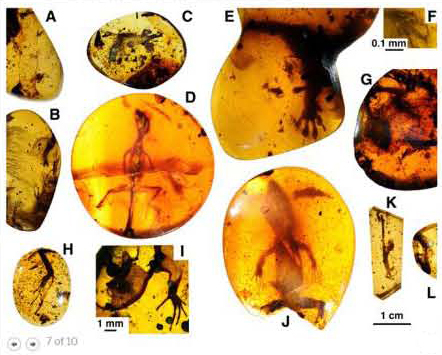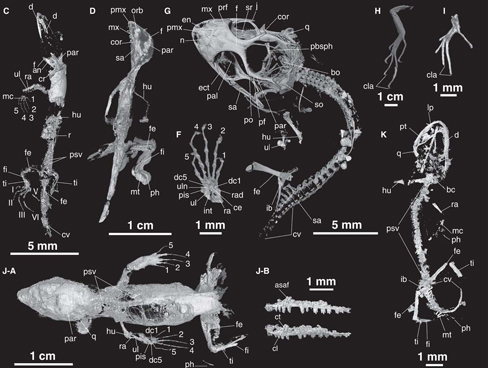Lizards Preserved in Amber
Lizards in Amber – A Window into a “Lost World”
Whilst much attention is focused on the Dinosauria when it comes to the fauna and flora of the Mesozoic, many scientists are busy piecing together the evolutionary relationships of a number of smaller reptiles, those creatures such as lizards that shared the world of the dinosaurs but so very little fossil evidence to indicate their existence has been preserved. Thanks to a new study of amber from Myanmar (Burma), undertaken by researchers based in the United States and Germany, a glimpse into a “lost world” has been permitted.
Amber from Myanmar
Mid Cretaceous Amber Preserves the Lizard Remains
Picture credit: Science Advances
The picture above shows some of the beautifully preserved lizard fossils in the Burmese amber (known as burmite). The fossil collection has been collated, some from American museums, many other pieces from private collections and they provide a record of the fauna and flora of a sub-tropical forest some 99 million years ago.
Key
(A) Lizard (body cavity empty, epidermis translucent)
(B) Lizard (epidermis translucent, hind leg preserved with bones)
(C) Lizard (intact specimen, with some tissue preserved)
(D) Lizard (skin and scales with some internal organs and bones)
(E) Stem Gekkota (ancestral to modern Geckos, hind legs, pelvic area and tail base preserved
(F) Stem Gekkota (manus including bones and impressions of toe pads)
(G) Stem Gekkota (skull material and spine with disarticulated limb and pelvic bones)
(H) Agamidae (left hind leg, including epidermis)
(I) Agamidae (translucent epidermis, pelvic with elements of the left limb and pes)
(J) Lacertoidea (skeletal elements preserved as internal casts and integument)
(K) Stem Chamaeleonidae (ancestral Chameleon with most of the skeleton preserved
Scale bar 1 cm for all photographs except (F) which has a scale bar of 0.1 mm and (I) with a scale bar of 1 mm.
Lizards Preserved in Amber
Writing in the open access journal “Science Advances” the scientists from Sam Houston State University (Texas), the American Museum of Natural History (New York), the Florida Museum of Natural History along with researchers from the California Academy of Sciences and the Bavarian State Collection of Zoology (Munich, Germany), have shed fresh light on the evolution and radiation of the Squamata. Ancestral forms of the Chameleon and Gecko families have been identified along with other lizard specimens that relate to the agamids.
Commenting on the study, one of the researchers, Dr Edward Stanley (Florida Museum of Natural History) stated:
“The fossilised amber provides a view into a lost world, revealing that the tropics of the Mid-Cretaceous contained a diverse lizard fauna.”
Oldest Lizard Assemblage Preserved in Amber
It is rare for such small creatures to be preserved as fossils. The specimens represent the oldest lizard assemblage preserved in amber known. In all, the twelve fossils preserve fine details of soft tissue and bone, allowing the scientists to gain a better understanding of how unique adaptations such as the sucker-like feet of the Gecko evolved. The fossil material was all collected from northern Myanmar (Kachin Province) and zircon crystals recovered from sediments in the Burmese amber outcrops that have been radiometrically dated indicate an age of around 99 million years. This places the age of the amber very close to the boundary between the Early and the Late Cretaceous (Albian-Cenomanian stage boundary).
Such is the degree of preservation that the scientists were able to obtain a great deal of information from the amber nodules.
Professor Juan Daza (Sam Houston State University) explained:
“We can pretty much see how the animals looked when they were alive. They [the fossils] provide a really nice snapshot of the past. To me it is like going back in time and doing a lizard collecting trip when we can see what these animals looked like.”
CT Scans and High Resolution Images Reveal Remarkable Detail
Picture credit: Science Advances
Fossilised Tree Resin
The amber (fossilised tree resin), provides a fascinating insight into some of the smaller organisms that lived alongside the dinosaurs during the Cretaceous. Fungi, plant remains including pollen and fern spores plus many different types of invertebrate remains have been identified from burmite.
For example, last year Everything Dinosaur reported on the discovery of a remarkably well preserved Cretaceous cockroach found in amber from northern Myanmar.
To read about this discovery: Cretaceous Cockroach – Deadly Nocturnal Predator.
Detailed Preservation
The detailed preservation of the lizard fossils permits scientists to identify characteristics helping to define and reassess the phylogenetic relationships between different groups. It has also given the researchers a surprise. The highly sophisticated projectile tongue, a characteristic of Chameleons has been identified in one of the specimens (K). The lizard in question, has been assigned to a basal position in the Chameleon family, the presence of the highly modified tongue suggests that this anatomical feature evolved very early on in these lizards, whereas, the absence in the fossil of those modified tree-grasping fused toes, indicates that the fused toes evolved much later.



